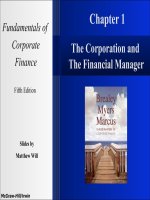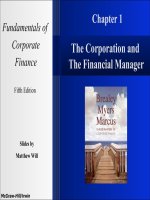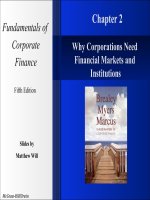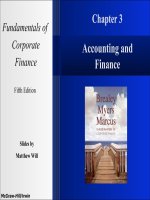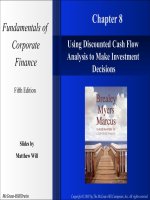2021 exam brief fundamentals of finance
Bạn đang xem bản rút gọn của tài liệu. Xem và tải ngay bản đầy đủ của tài liệu tại đây (774.38 KB, 5 trang )
EXAMINATION (online)
Big Assignment
Lecturer’s Signature& full name
Program: VNU
Course Code: INS2015
Course Title: Fundamentals of Finance
Level: UG
Time allowed: Before 12 pm, 20/8 /2021
Due date: 20/8 /2021
Date: 12/8/2021
Department’s Signature & full
name
Nguyễn Thị Kim Oanh
Date: ………………………………
Instructions to students:
1. Closed/Opened book examination: Opened book
2. Submitted your project as a PDF file
3. The file name is as follows: Student name_Student number_Course code
(Example: Nguyễn Văn A_19071122_INE1050.01)
This exam paper contains 5 pages, including the cover page.
Knowledge
1. Critical understanding of the key strategic decisions that a business may have to
make and appreciated how accounting and finance can assist in making and
evaluating those decisions.
2. Critical understanding of specific analytical skills in key decision areas within
strategy and finance at local and international level.
3. Critical understanding of the limitations of the current state of financial theory in
making strategic business decisions.
Skills
Competence in applying the key valuation concepts and methodologies of financial decision
making to contribute to the wider decision making of the organisation.
Requirements:
Select and attempt any TWO from the following three questions. Each part that is
attempted will carry a maximum mark of 50%.
Assessment guideline:
•
Weighting – 60% of the marks for this module
•
This is an individual assignment of 2,000 words. (+ 10%)
•
The hand in date is: 20th Aug 2021
Submission Requirements:
-
Submitted your project as one PDF file
-
The file name is as follows: Student name_Student number_Course code
(Example: Nguyễn Văn A_19071122_INE1050.01)
Question 1
Grey Ltd has provided the following figures for two investment projects, only one of which may
be chosen.
Project X
Project Y
£
£
Initial outlay
200,000
180,000
Profit for year 1
65,000
35,000
2
65,000
35,000
3
75,000
65,000
4
35,000
85,000
60,000
40,000
Estimated resale value at end of year 4
Profit is calculated after deducting straight line depreciation. The business has a cost of capital of
10%.
Required
a) Calculate for each project
i.
Payback
ii.
Average Return on Capital Employed
iii. Net present value (NPV)
b) Critically discuss the merits and limitations of payback and NPV
(Your answer is to be presented in an essay format NOT Bullet Points)
(25 marks)
(25 marks)
(50%)
Question 2
To what extent does the dividend policy of a company influence its share price?
Critically evaluate both the dividend relevance and dividend irrelevance theoretical
viewpoints, ensuring the response is supported with relevant academic research.
In this section students should demonstrate both knowledge and understanding of the
dividend relevance and irrelevance theoretical viewpoints and of the differing views on its
importance to share price. The evaluation should be supported with appropriate empirical
research that has been performed within this area and should be referenced as per Harvard
referencing requirements. The response should also demonstrate an ability to incorporate
real-life practical business examples, addressing whether differing companies adopt a
dividend relevance or irrelevance standpoint. The inclusion and development of numerical
examples to support and enhance the discussion would be beneficial although should not
form the main basis of the work.
(50%)
Question 3
In practice financial managers should make decisions that are consistent with the primary
objective of maximizing shareholder wealth, yet whether this philosophy is consistently applied
is open to debate. Critically evaluate and analyse the differing ways in which the shareholders of
a company can encourage its managers to act in a manner that does align with the objective of
maximizing shareholder wealth.
Within this section of the assessment students should demonstrate knowledge, understanding,
and an ability to critically evaluate agency theory, and the pivotal role it plays within financial
management. The response should clearly identify techniques that can be implemented and used
by shareholders to address and reduce the agency problem that is faced by many businesses. A
critical evaluation of relevant, contemporary academic literature should be performed, rather
than placing an over emphasis upon overly describing the core concepts. Evaluation and
integration of real-life examples where shareholders have actively attempted to address or
reduce agency problems would assist in developing and enhancing the response offered.
(50%)
Guidance:
Students should approach the written elements of this assignment as an academic essay,
weighing the arguments for and against each issue, making comment on the literature and
drawing logical conclusions. Academic referencing using the Harvard referencing approach
is a key requirement of the assignment to demonstrate wider reading and to underpin the
discussions, ensuring they have relevant depth.
Marking Guide
The learning outcomes for this module assessed by this piece of work are:
1.
2.
3.
4.
Knowledge
Examined and critically evaluated the key strategic decisions that a business may have to
make and appreciated how accounting and finance can assist in making and evaluating those
decisions.
A critical understanding of specific analytical skills in key decision areas within strategy and
finance at local and international level
A critical understanding of the limitations of the current state of financial theory in making
strategic business decisions
Skills
Applied the key valuation concepts and methodologies of financial decision making in order
to contribute to the wider decision making of the organisation

